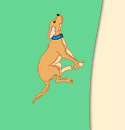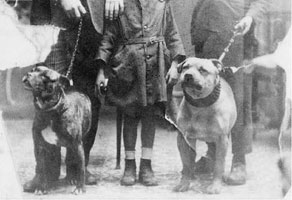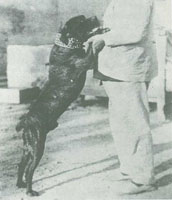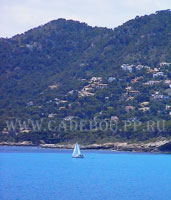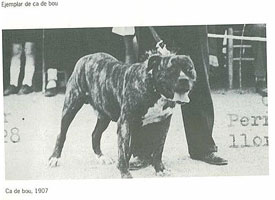History and origin of breed Ca de bou
The history of ancient breeds conceals in itself many riddles and "white spots", to fill which absolutely with established facts is impossible. Only collecting the particles of memoirs of contemporaries, links to literature and works of art, we can imagine ways of their development. Do not make exception and Ca de bou.
Short history of cadebou (from standard of breed FCI № 249)
Since ancient times, seafaring from East to West in the Mediterranean region has led to the exchange of culture and science between nations. These reciprocal relations, even though mainly of a commercial nature, also gave the opportunity for an exchange of domestic animals. Amongst these were watch and guard dogs which were needed in harbours and coastal settlements as a protection against pirates and robbers coming in by sea. Amongst these mostly large, strong, resistant dogs with large heads and powerful teeth, one type distinguished itself. It was the mastiff of the Iberian Peninsula, which, in Spain, was used in various areas as a hunting or as a fighting dog against bulls and other dogs. This breed accompanied King Jacob 1 on his conquests and arrived in the Balearics about the year 1230. In the 17th century, Minorca and others areas came into British possession, following the treaty of Utrecht. The British brought their own fighting and guard dogs with them into the Balearics and crossed them with the native mastiffs of the Iberian Peninsula, which also occurred in the Balearic Isles. In the beginning of the 18th century, fights between dogs and bulls (bull baiting) were very popular and the Britons inhabiting the Island looked for a breed which would be held suited to such fights. These circumstances explain the name "Ca de Bou", Bull Dog. In the Spanish Stud Book for the year 1923, the existence of this breed is already established. The first official entry was in the year 1928 and in 1929, when such a breed was exhibited for the first time at a Dog Show in Barcelona.
Version Otto Brito and Tim Taylor
Our breed is a really wonderful breed. A breed so hard and rustic, insensitive to pain and never sick, a wonderful family dog, very loving with children, yet, very wary of strangers. A breed which has been used for almost any type of work a dog can do.
The Ca de bou descends from the old Alans and Presa dogs brought during the early days of conquest of the Balearics (12-14 century). Through crosses with dogs on the island, these became very useful dogs for the butchers who used them to hold the bull while they slaughtered it, thereof the origin of the name Ca de bou, Can(Dog) de(of) Bou(Bull).
The Ca de bou also became a weapon used for and against the law, since it was a breed with exceptional abilities and easily trained. During the 1700 to early 1900s the Ca de bou gained the reputation it has today. It was used as a butcher's dog, a warrior in the fighting arenas, fighting bulls, leopards, hyenas and other Ca de bous. The breed was mentioned by the President of the Dogue de Bordeaux Club in a French magazine in the 1920s, when the best of each breed met in Madrid for a fighting match.
At this time, the Ca de bou was used as a guard dog, a farm dog, herder, fighter, and bull catcher. Its working abilities were unmatched. We must understand that the Ca de bou was not the only indigenous, rustic breed in Mallorca, the Ca de Bestiar, a great herder and guard was also a well known indigenous breed. And it is extremely important to remember that both breeds had a lot to do with each other over the years as it is a well known fact that functionality was the only criteria used when breeding in the old days.
The Ca de bou was a powerful bull worker with a very strong constitution and the Ca de Bestiar was a swift herder and by no means an angel. The breeds were often crossed with each other to acquire dogs that were capable of doing almost anything. It was this known fact that served as a basis for the recovery of the breed and its genetic makeup. Although the Ca de Bestiar of today has been bred to look somewhat smaller, it was the old Ca de Bestiar dogs with large powerful bodies, strong necks and thick bone that had a lot of Ca de bou in them, and due to the high percentage of Ca de bou blood in them, these were the ones used during the recovery of the Ca de bou.
Back in the early 1990s and even now as well the occasional old type of Ca de bou is still being found. It is very rare to find them but it does happen. Tim remembers the long discussions they used to have of the importance of crossing excellent brindle Ca de Bestiar with Ca de bou to see what the crossing can produce as it it can produce some very rustic, special Ca de bou. He also remembers the magnificent 10 year old brindle rustic Ca de bou, a superb specimen. Which he had planned to use on his bitch Alga.
An old friend of Tim recorded interviews with old men about the memories of the Cadebou as they remember it. Talking about old brindle Ca de bou and other dogs they have special memories of. This material is very important for the breed.
Even today we can see some pups of Ca de bou type being born in modern Ca de Bestiar litters, and also dogs that have obvious characteristics from the Ca de bou, like the brindle color. The brindle color in the Ca de Bestiar has always been sought after.
The Ca de Bestiar, inherited the brindle color from the Ca de bou, and even though the brindle color was recently "wrongly" dropped from the breed standard for the Ca de Bestiar (its history dates of more than 100 years), today we still see some Ca de Bestiar litters drop a brindle once in a while. These specimens, when crossed with a typical Ca de bou, produce excellent specimens that then could become if typical enough, original register. This is not very common today, (but it is still done).
It is also a fact that one used to see pups of typical Ca de Bestiar type in Ca de bou litters. It is very interesting that even though we have many owners in the breed, there are indeed very few who know about its recovery and its origins.
Due to a lot of bully type Ca de bou seen in the show ring in Europe it has become a common but VERY sad misconception that our breed should appear bulldogish, when nothing is further from the truth.
Any resemblance to any other breed is to be considered a very serious fault.
It is true that some Ca de bou carry English bulldog in their genetic makeup, but this was proven not to be beneficial for the breed as we know it produced the following serious faults in the breed:
- Too much white.
- Very separated elbows.
- Exagerated prognatism.
- Chest too low.
What it did give to breed was excellent rose ears.
The breeders who did not take the breed seriously have now left the breed and left are the breeders wanting to breed true to type and now we can see that a majority of the dogs coming out of Spain are of excellent type as they come from breeders who are breeding true to type from the original dogs.
Source of photos: www.cadebou-friends.info/forum/; Zakharova M. - photo of Mallorca 2005 year.
